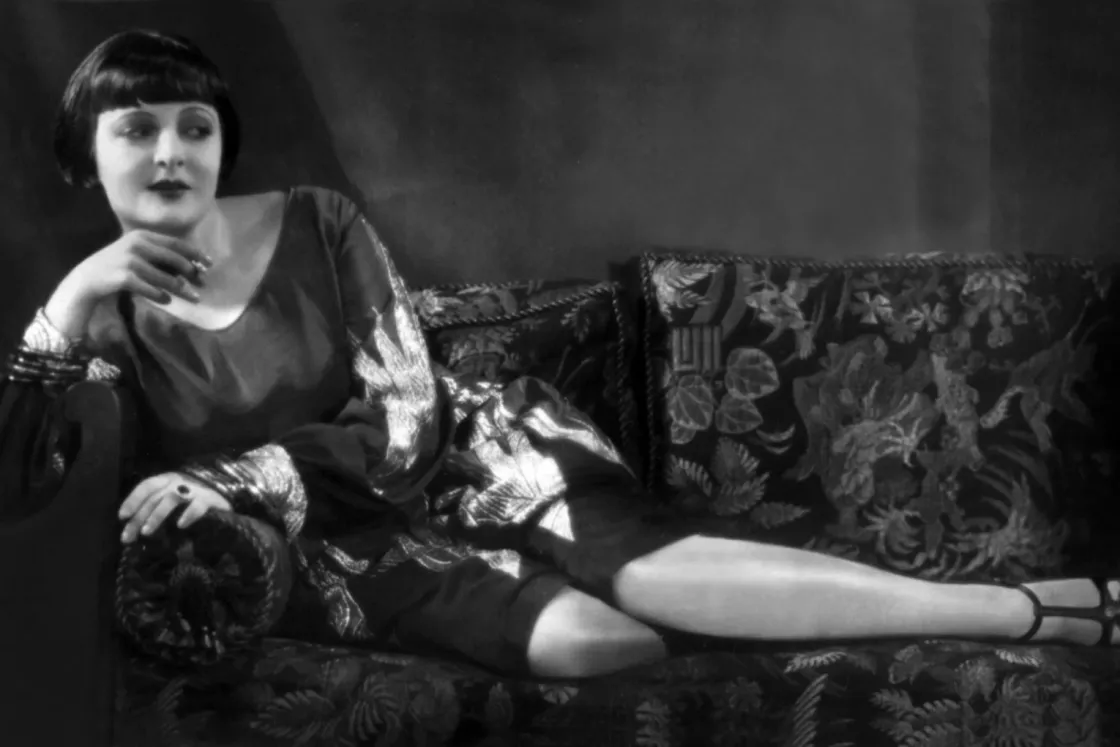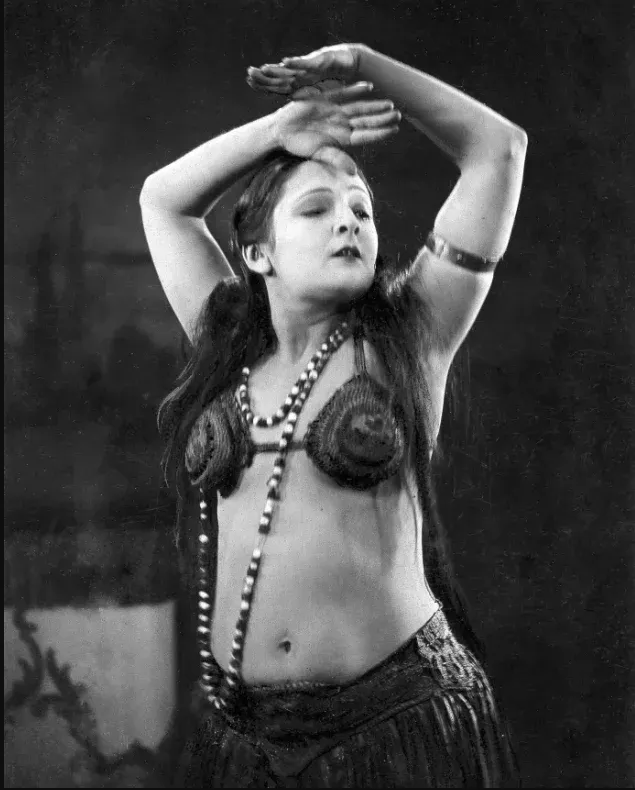The first world-famous Hungarian actress, whose career was ruined by the appearance of talking pictures
August 14. 2024. – 04:54 PM

One hundred years ago, in early February 1924, Lia Putty, the famous Berlin film diva, had a serious accident while filming a movie, Hungarian and Czechoslovak newspapers reported.
"She had to chase a speeding train on a highway in a car during a film shoot. At a sudden bend, the car swerved into a ditch and Lia Putty was thrown under the car. She suffered external and internal injuries. Filming was stopped indefinitely."
– the daily paper of Kosice (Kassa) reported.
The reason why the newspaper gave the actress a special mention was because she was born in Vécse, forty kilometres from Kassa and thirty-five from Sátoraljaújhely. Born on 10 January, 1897, Amália was the fourth, youngest child of the Italian Baron Gyula Putti, a hussar colonel, and Countess Mária Hoyos. It was not expected that she would turn to acting, for as early as 1913 she married the Chief Constable of Nyíregyháza Zoltán Szepessy, whom she met at a ball and immediately fell in love with.
Szepessy took her to his castle in Gibárt near Encs on a four-horse carriage. At 16, Putty (her name was always written with a y and not an i) gave birth to her first daughter, and a year and a half later to her second. Her romance with a hussar captain suggests that their marriage was not the happiest, and she then left her family, if only for two weeks. The affair was merely a fling, and Szepessy would have taken her back to his estate after she repented, but the family was adamant and would not forgive her for her lapse. According to one account, Putty was so distressed by her father-in-law's unyielding attitude that she tried to kill herself,
but her attempted suicide was fortunately unsuccessful, and soon the whole world got to know her name and many of her performances.
Leaving behind the quiet life in the countryside, she made her first appearance as a dancer at the Royal Orfeum in Budapest at the age of 20 in 1917. One performance followed another, and she quickly became a favourite with the audience. According to a family story once, while on holiday at Lake Balaton, Endre Ady, the famous poet suggested that she should use her beauty to her advantage and become an actress for that reason alone. Her daughters, meanwhile, were under the impression that their mother had died, only to discover much later, by chance, that their grandparents had lied to them about it.
She had her first leading role in 1918 in the silent film Soldiers of the Emperor. Her performance was not bad, but she received criticism for her weight: if she wanted to be successful, she had to lose weight urgently. The First World War had almost no impact on Hungarian film production, with over a hundred films being made in its final year. After the collapse of the regime, however, Putty left the country, arriving in Berlin via Oradea (Nagyvárad) and Bucharest.
She showed up in Nagyvárad in 1919 as a real diva, and even a minor scandal developed around her. The owner of the Park Hotel was sentenced to five days in jail because of her: he refused to give her a room because he didn't agree with renting a room to an unmarried woman. His explanation was that he did not want to go against his principles. When the owner returned after five days of detention, Putty was reported to have waved to him coaxingly from the largest suite. Whether she was actually expelled from Bucharest, as reported in the newspapers of the time, and what love affair she had there, is difficult to reconstruct.
In any case, she then headed to Berlin, where she performed in nightclubs. the Viennese Richard Oswald immediately saw that she was destined for the screen and presented her with her first opportunity abroad. In 1921, she was offered the role of a dancer in Hindu Tomb, which fit her well. She received favourable reviews, her wonderful figure was praised, and as a result, she was offered more and more roles, and then the leading German star with Polish roots, Pola Negri, was signed to an American contract in 1923. Here was a chance for Lya de Putty, as she was becoming known, to fill the void Negri had left in the German capital.
The scare of the accident mentioned above in the introduction was bigger than the actual injury, and after a temporary break, Putty returned to filming with even greater vigour. Between 1920 and 1926 she shot sixteen films in Germany. Variety, made in 1925, was a success not only in Europe but also in the United States, which led to increased interest in the actress. It was the film that made her world-famous, even if some scenes had to be cut out to allow it to be shown in all the states of the US.

In this film, Putty seduces an injured, aging, married acrobat played by Emil Jannings. They fall in love, but their love is more dangerous than any element on a trapeze, and together they rush to their doom, which inevitably comes.
The success of the film attracted the interest of Paramount Pictures, and Putty signed a contract every actress at the time longed for in the company's Paris office with Adolf Zukor, the founder of the studio. Zukor was also of Hungarian origin and had made an exceptional career in America. Interestingly enough, Putty and Zukor were born 70 kilometres apart. But the film The Sorrows of Satan ended up being a disappointment. Her next two films were not box-office successes either, which was a message to Zukor as well.
In these films, Putty mostly embodied the seductress of doom, just like in Europe. This erotically hypercharged role – a term that should be understood in the context of the time – was not to her liking, and she tried to break out of it, showing her talent as a positive character and not always as a despicable lover.
"I have been pigeonholed as the woman of doom. Newspaper gossip columns say I spread broken men's hearts on my buttered bread. But the truth is, I am not a man-eating demon.
I've always hoped that fate would bring me much happiness, true, blazing, great love. I was disappointed. Love is lost, it dies in the hustle and bustle of the studio, of work," she lamented.
In 1927, hoping to finally find worldwide success in Hollywood, she left Paramount and joined Universal. Although critics praised her performance in The Heart Thief, in which she played a lovable woman, she was not entirely satisfied, as the film was a mediocre success. Her next film was not the breakthrough she had hoped for either, although she even had a nose job done to prevent her characteristic facial features from getting in the way of success. She also wanted to show her comic side in comedies, but no one else saw in her the flair she thought she had.

Seeing temporary failure, she returned to Germany, and as the film she made there was praised, another major American studio, Columbia, made her an offer. Although she didn't like the script for Scarlet Lady, she took it because it was a melodramatic lead role. On her return to the US, she encountered a problem: her visa had expired and she was not allowed to enter the country, and the film company had to use its influence to make it possible for Putty, who was meanwhile passing time in Cuba, to be allowed to work.
But the real hardships were still to came.
The film was well received and a success, but Putty still feared being pigeonholed, so she went to London instead, and in 1929 started work on Informer, which would be her last role, although she did not know it at the time. Because of the rise of the sound film, she had to do a sound test, which failed. She had to be dubbed in the dialogues because of her strong accent, which was very hard on her. By this time, the typical roles she played were gradually going out of fashion in the film industry. On top of this, she struggled with depression, as she could not marry her lover, Walter Blumenthal, because the New York banker's family vehemently opposed it.
In 1931, Putty gave herself one last chance to see if luck would smile on her in Europe. It didn't. She was no longer enthusiastically received in Berlin, and her roles on stage did not lift her to the heights either. She became increasingly desperate and went back to New York with her head down. She was neglected and felt hopeless, so she went on a hunger strike, and one night she took a bite of a sandwich too greedily and a chicken bone got stuck in her throat. A quick surgery helped save her life, but then she developed septicaemia, and further complications set in. The doctors fought for her life, but weren't able to help her in the end. She died in November 1931, aged 34.
Some American papers reported that she had committed suicide, but this was fake news. A confidante, Romola Nizinsky, told the Pesti Napló newspaper that although she had been previously plagued by a fear of death, she was loving life very much and had been planning her wedding. She was buried in pouring rain in New York. Only fourteen people were there to see the great idol of an era to her final resting place. Her husband, Szepessy, had sent her two huge bouquets of red roses from home, but they didn't not make it in time for the ceremony. A year later, at the end of the Great Depression, he committed suicide in a hotel in Budapest.
Either way, Putty made a big impression not only on film fans – her relics and her posters have been collected in many parts of the world – but also on actresses. She was one of Liza Minnelli's favourites, and it was her Minnelli commemorated in 1972's Cabaret, bringing her style and graceful, passionate movements to life, wearing – not coincidentally – a black wig.
For more quick, accurate and impartial news from and about Hungary, subscribe to the Telex English newsletter!